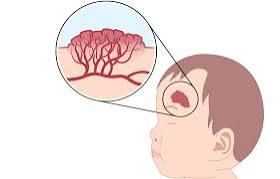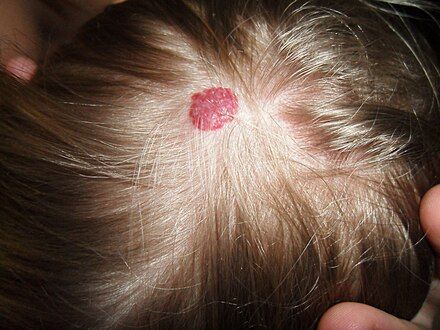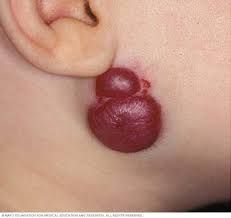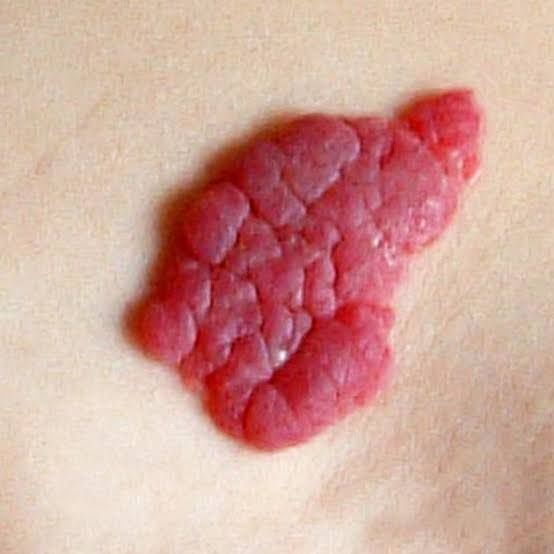A haemangioma is a benign or localized vascular tumor derived from blood vessel cell types.
It is most commonly seen in infants otherwise called an infantile haemangioma. It is sometimes colloquially referred to as a "strawberry mark" which is observed on the skin at birth(natal mark) or postnatally in the first weeks of life.
A haemangioma can be spotted on any parts in the body, but most commonly observed on the face, scalp, chest or back.
They tend to develop and sprout for up to a year before gradually disappearing and fade off as the child gets older. A haemangioma may necessitate treatment intervention if it is likely to interferes with vision, respiration or is possibility to cause long-term disfigurement of the esthetic appearance.
In rare occasions, hemangiomas occuring internally can result or contribute to morbidity of other medical disorders. Though normally hemangiomas disappear in 10 years.
In case of pharmacological interventions, beta blockers should be considered as first line treatment options, which has proven to efficacious in majority of cases.
Haemangiomas that form natally at birth are referred to as congenital haemangiomas, while those that form later in life especially during the earlier weeks after birth are called infantile haemangiomas.
Haemangiomas are localized non-metastatic vascular tumors which are different types.
The most common recent ones are the infantile hemangiomas, and congenital hemangiomas.
Infantile Haemangiomas
Infantile haemangiomas are the most common benign tumor found in children. They consist of
malformed blood vessels which developed into marks and spots often referred to as strawberry marks, and are noticed to occur frequently in girls than boys.
Premature babies that are born too earlier than the normal usual duration are more likely suffer from this tumour.
Infantile haemangiomas are usually spotted on the skin of infants in the early days or weeks after birth. They tend sprout and grow up to a year after which they shrink or involute and fade off without complications, though in some cases some haemangiomas ulcerate and form disjointed epithelium which can be severely painful.
Esthetic makeup and appearance could be compromised depending on location and size of haemangiomas leading to some sort of disfigurement.
Haemangiomas is not only excluded to the skin and other external body structures but can also occur in the internal organs of the body such as the airway tract, brain and liver among others and in rare occasions could be related to the disorders of the central nervous system.
As regards the observable colour of haemangiomas, their colours are usually displayed and noted based on how deep it is in the skin which could be superficial and deep.
Superficial (situated near the skin's surface) hemangiomas tend to have bright red colour; and deep (further and deep down the skin's surface) hemangiomas are noticed to be blue or purple, that is more deeper than bright red colour; and last but not least mixed hemangiomas may have the colour combination of both superficial and deep types.
Congenital Haemangiomas
Congenital hemangiomas are highly spotted and noticed on the skin at birth, as opposed infantile hemangiomas, which appear later during the cycle of life.
They are fully developed at birth, depicting that they do not grow and sprout after a child is born, as in the case of infantile hemangiomas. They are less frequent in occurrence than infantile hemangiomas.
Congenital hemangiomas may have colours ranging from pink to blue.
"Congenital hemangiomas are classified according to whether they shrink and go away, or do not shrink, and do not go away, or partially shrink. Those that shrink are known as rapidly involuting congenital hemangiomas (RICH) and go away quickly. Those that do not shrink, and remain are known as noninvoluting congenital hemangiomas (NICH). Others that partially shrink are known as partially involuting congenital hemangiomas (PICH)."Source
That's all at least for now on haemangiomas and the concluding part of the post would be posted subsequently in order to avoid lengthy and voluminous paragraphs. Thanks for following up to this segment of the write-up and happy blogging and reading.
Happy Blogging and Reading
Video from Easy Dentistry YouTuber




Telegram and Whatsapp